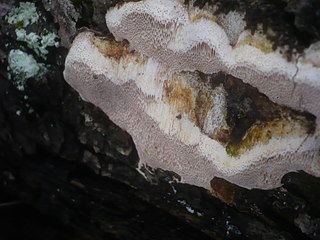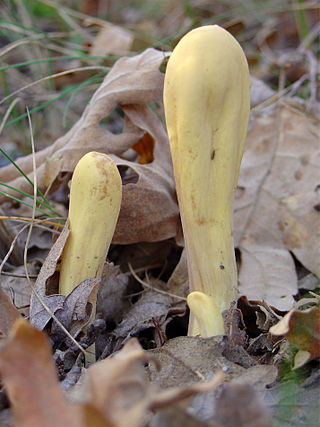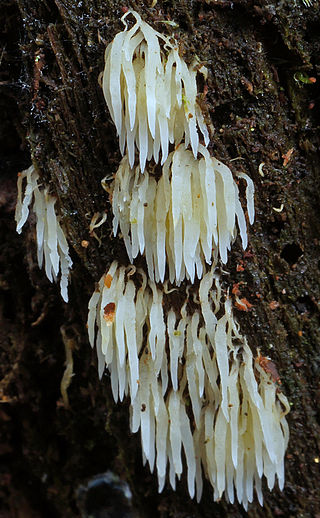
Polyporus is a genus of poroid fungi in the family Polyporaceae.

The Clavariaceae are a family of fungi in the order Agaricales. Originally the family contained most of the clavarioid fungi, but in its current sense is more restricted, albeit with a greater diversity of basidiocarp forms. Basidiocarps are variously clavarioid or agaricoid (mushroom-shaped), less commonly corticioid or hydnoid.

Gomphus is a genus of cantharelloid fungi in the family Gomphaceae. Once presumed to be related to chanterelles, molecular study has shown them to be allied with stinkhorns and fairy clubs. The type species of the genus is the pig's ear (G. clavatus).

Perenniporia is a cosmopolitan genus of bracket-forming or crust-like polypores in the family Polyporaceae. They are dimitic or trimitic with smooth, thick-walled basidiospores and cause a white rot in affected wood.

Blastocladiomycota is one of the currently recognized phyla within the kingdom Fungi. Blastocladiomycota was originally the order Blastocladiales within the phylum Chytridiomycota until molecular and zoospore ultrastructural characters were used to demonstrate it was not monophyletic with Chytridiomycota. The order was first erected by Petersen for a single genus, Blastocladia, which was originally considered a member of the oomycetes. Accordingly, members of Blastocladiomycota are often referred to colloquially as "chytrids." However, some feel "chytrid" should refer only to members of Chytridiomycota. Thus, members of Blastocladiomyota are commonly called "blastoclads" by mycologists. Alternatively, members of Blastocladiomycota, Chytridiomycota, and Neocallimastigomycota lumped together as the zoosporic true fungi. Blastocladiomycota contains 5 families and approximately 12 genera. This early diverging branch of kingdom Fungi is the first to exhibit alternation of generations. As well, two (once) popular model organisms—Allomyces macrogynus and Blastocladiella emersonii—belong to this phylum.

Fomitopsis is a genus of more than 40 species of bracket fungi in the family Fomitopsidaceae.

Postia is a genus of brown rot fungi in the family Fomitopsidaceae.

Gloeoporus is a genus of crust fungi in the family Irpicaceae. The genus has a widespread distribution.

Phylloporus is a genus of fungi in the family Boletaceae. The genus has a cosmopolitan distribution, and contains about 50 species, mostly in tropical areas.

Clavariadelphus is a genus of club fungi in the family Clavariadelphaceae. The genus has a widespread distribution in temperate areas, and contains an estimated 19 species. The name might mean uterus-shaped club, from the Latin clava meaning club and the Greek delphus meaning uterus.

Ramariopsis is a genus of coral fungi in the family Clavariaceae. The genus has a collectively widespread distribution and contains about 40 species. The name means 'having the appearance of Ramaria'.

Antrodiella is a genus of fungi in the family Steccherinaceae of the order Polyporales.

Amauroderma is a genus of polypore fungi in the family Ganodermataceae. The genus, widespread in tropical areas, contains about 70 species. Amauroderma fungi are wood-decay fungi that feed and fruit on decayed branches and trunks.

Mucronella is a genus of fungi in the family Clavariaceae. Species in the genus resemble awl-shaped teeth that grow in groups without a common subiculum.

The clavarioid fungi are a group of fungi in the Basidiomycota typically having erect, simple or branched basidiocarps that are formed on the ground, on decaying vegetation, or on dead wood. They are colloquially called club fungi and coral fungi.

Multiclavula is a genus of basidiolichens in the family Hydnaceae. The widespread genus contains 14 species.

Clavulinopsis helvola is a clavarioid fungus in the family Clavariaceae. In the UK, it has the recommended English name of yellow club. It forms slender, cylindrical, yellow fruiting bodies that grow on the ground in agriculturally unimproved grassland or in woodland litter. It was originally described from Europe.

Clavulinopsis laeticolor is a clavarioid fungus in the family Clavariaceae. In the UK, it has the recommended English name of handsome club. It forms slender, cylindrical, yellow fruit bodies that grow on the ground in woodland litter or in agriculturally unimproved grassland. It was originally described from Cuba and is part of a species complex as yet unresolved.

Clavulinopsis sulcata is a clavarioid fungus in the family Clavariaceae and is the type species of the genus Clavulinopsis. It forms very long, slender, cylindrical pinkish or orange fruiting bodies that grow on the ground among plant litter.
Liu, L.-N., Wu, L., Chen, Z.-H., Bau, T., & Zhang, P. (2017). The species of Lentaria (Gomphales, basidiomycota) from China based on morphological and molecular evidence. Mycological Progress, 16(6), 605–612. https://doi.org/10.1007/s11557-017-1284-2



















